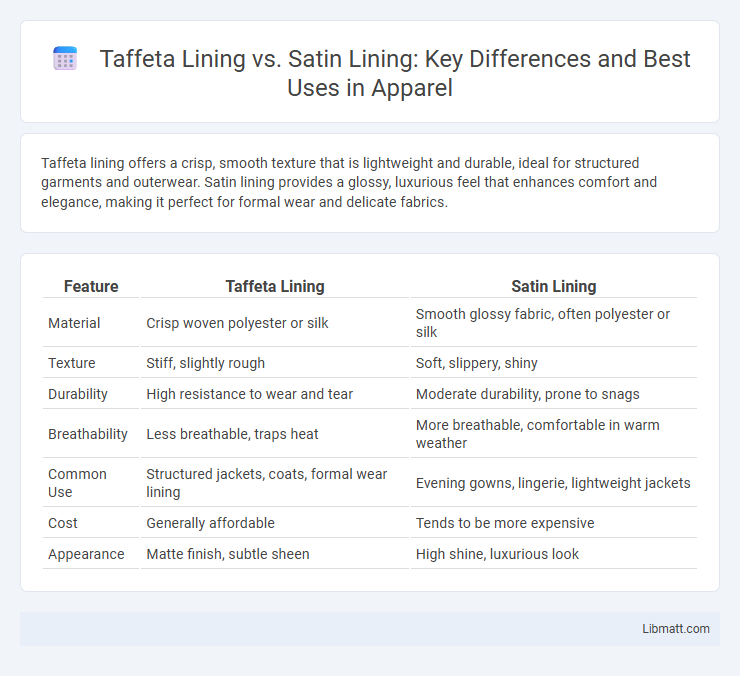Taffeta lining offers a crisp, smooth texture that is lightweight and durable, ideal for structured garments and outerwear. Satin lining provides a glossy, luxurious feel that enhances comfort and elegance, making it perfect for formal wear and delicate fabrics.
Table of Comparison
| Feature | Taffeta Lining | Satin Lining |
|---|---|---|
| Material | Crisp woven polyester or silk | Smooth glossy fabric, often polyester or silk |
| Texture | Stiff, slightly rough | Soft, slippery, shiny |
| Durability | High resistance to wear and tear | Moderate durability, prone to snags |
| Breathability | Less breathable, traps heat | More breathable, comfortable in warm weather |
| Common Use | Structured jackets, coats, formal wear lining | Evening gowns, lingerie, lightweight jackets |
| Cost | Generally affordable | Tends to be more expensive |
| Appearance | Matte finish, subtle sheen | High shine, luxurious look |
Introduction to Fabric Linings
Fabric linings serve as essential components in garments, providing structure, comfort, and durability. Taffeta lining is a crisp, smooth fabric known for its lightweight and slightly stiff texture, often preferred for formal wear due to its lustrous finish. Satin lining offers a glossy, soft surface that enhances comfort and elegance, making it ideal for luxury clothing and evening gowns.
What is Taffeta Lining?
Taffeta lining is a crisp, smooth fabric made from tightly woven silk or synthetic fibers, providing a lightweight yet durable inner layer for garments. Known for its rustling sound, taffeta lining enhances the structure and shape of clothing while offering breathability and resistance to moisture. You can choose taffeta lining to add a polished finish and a touch of luxury to suits, jackets, and formal wear.
What is Satin Lining?
Satin lining is a smooth, glossy fabric commonly made from silk or polyester, prized for its luxurious feel and elegant sheen. It provides a lightweight, breathable layer often used in high-end garments and accessories to enhance comfort and improve garment structure. Your choice between satin and other linings like taffeta depends on the desired texture, appearance, and functionality of the finished piece.
Key Differences Between Taffeta and Satin Linings
Taffeta lining is crisp and lightweight with a matte finish, offering durability and breathability, while satin lining is smooth, glossy, and more luxurious but less breathable. Taffeta is often used in outerwear or structured garments due to its stiffness, whereas satin lining enhances comfort and elegance in eveningwear and formal attire. Understanding these key differences helps you choose the right lining to balance comfort, aesthetic, and function in your garment.
Texture and Appearance Comparison
Taffeta lining features a crisp, smooth texture with a subtle sheen, offering a structured and slightly stiff feel that enhances garment shape. Satin lining is known for its glossy, lustrous surface and silky smooth touch, providing a luxurious and fluid drape that feels soft against your skin. Your choice between taffeta and satin linings will impact the overall look and tactile experience of the garment, balancing body and shine.
Durability and Maintenance
Taffeta lining is known for its durability, offering excellent resistance to tearing and abrasion, making it ideal for garments that require long-lasting support. Satin lining provides a smooth, luxurious feel but is more delicate and prone to snagging or pilling, requiring careful maintenance such as gentle hand washing or dry cleaning. Choosing taffeta ensures easier upkeep and extended garment life, while satin demands more attentive care to preserve its sheen and softness.
Comfort and Breathability
Taffeta lining offers a crisp, smooth texture with moderate breathability, making it suitable for structured garments that require lightweight support. Satin lining, known for its luxurious sheen and silky feel, provides superior softness against the skin but may trap heat, reducing breathability. Choosing your lining depends on whether you prioritize a cooler, breathable interior (taffeta) or a sumptuous, comfortable touch (satin).
Best Uses for Taffeta Lining
Taffeta lining is ideal for structured garments such as coats, jackets, and formal dresses due to its crisp texture and ability to maintain shape. Its smooth, lightweight, and slightly shiny surface reduces friction with outer fabrics, ensuring ease of wear. Taffeta is also favored in eveningwear and bridal gowns for its elegant sheen and durability.
Best Uses for Satin Lining
Satin lining is ideal for formal wear, bridal gowns, and evening dresses due to its smooth, glossy surface that enhances elegance and comfort against the skin. Its lightweight and breathable properties make it suitable for garments requiring a luxurious feel without added bulk, ensuring Your outfit maintains a sleek silhouette. Satin lining also excels in draping smoothly, preventing fabric cling and providing a polished finish to high-end apparel.
Choosing the Right Lining for Your Project
Selecting between taffeta lining and satin lining depends on the desired texture and durability of your project. Taffeta lining offers a crisp, structured feel ideal for tailored garments and outerwear, providing breathability and resistance to wrinkling. Satin lining delivers a smooth, glossy finish perfect for luxurious comfort and elegance in evening wear or high-end fashion pieces.
Taffeta Lining vs Satin Lining Infographic

 libmatt.com
libmatt.com